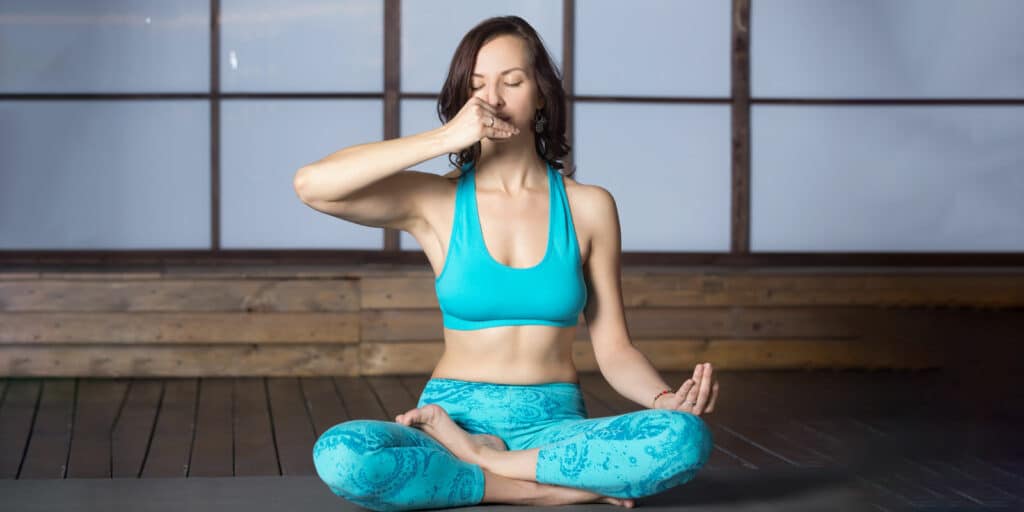Pranayama – A Theoretical Understanding
by Soha Akbar

As yoga practitioners, we are usually drawn first to asanas and the physical benefits that come along with it. For many beginners, it might also be the fascination of being able to bend and balance the body in various postures. Rarely does someone starting yoga approach the teacher enquiring about pranayama. Given my own experience, I empathize with practitioners who are not attracted to Pranayama right away. The idea of using breath to improve one’s physical and mental state might seem vague or incomprehensible at first. But the more you practise and learn, the more you are interested in exploring this science.
What is Pranayama?
So, what is Pranayama? Usually defined as breath control by most people, it has a lot more to it. Although this understanding may seem correct considering the breathing practices involved in pranayama, it does not express the meaning of the term in its totality.
BKS Iyengar explains in his book ‘Light on the Yoga Sutras of Patanjali’: Normally the flow of breath is unrestrained and irregular. Observing these variations, and conditioning the mind to control the inflow, outflow and retention of the breath in a regular, rhythmic pattern, is pranayama.
What is Prana?
The word ‘pranayama’ is comprised of two roots: ‘prana’ and ‘ayama’. Prana means the invisible and intangible life force or vital energy, and ayama means expansion or extension. So, in the most basic sense, pranayama is the expansion of the dimension of life force.
And what do we mean when we say that prana is the life force? It can be understood as the power flowing in all life forms and performing all the vital functions. In respect to the human body, the Yogic philosophy believes that there are thousands of invisible energy channels called ‘nadis’ in the body, through which prana, or life energy, flows. If there is any kind of obstruction in the nadis, the flow of prana is interrupted, resulting in diseases and ailments.
Prana and Breath
How is prana connected with breath? When we breathe, there is a corresponding movement of prana in the body. By regulating the breath, which is easier to understand and distinguish, one can influence the flow of prana, which is much more subtle and cannot be perceived easily. Here we understand the role of pranayama, where the breath is regulated using different techniques, in order to expand the dimension of prana.
In the Yoga Sutras of Patanjali, verse 49 of chapter 2 states:
तस्मिन् सति श्वासप्रश्वासयोर्गतिविच्छेदः प्राणायामः
[tasmin sati shvasa prashvsayoh gati vichchedah pranayama]
It means ‘Pranayama is the regulation of the incoming and outgoing flow of breath with retention. It is to be practised only after perfection in asana is attained.’
Why does Patanjali instruct to progress from asanas to pranayama? When asanas are practised regularly, our energy blockages are removed; the muscles get toned and one is able to sit for longer durations keeping the spine erect; the lungs are trained to expand and the spinal nerves are stimulated to draw energy from the breath. Hence, one is able to maximize the benefits of pranayama.
It is said in Hatha Yoga Pradipika, chapter 2, verse 1:
अथासने दॄधे योगी वशी हित-मिताशनः |
गुरूपदिष्ह्ट-मार्गेण पराणायामान्समभ्यसेत ||
[athasane drdhe yogi vashi hita mitasanaha Gurupadishta margena pranayaman samabhyaset]
It means, ‘Thus being established in asana and having control (of the body), taking a balanced diet; pranayama should be practised according to the instructions of the guru.
Since pranayama is more than simple breathing exercises, it should not be started until the appropriate pranayama to be practised is indicated by the teacher. It must be practised systematically under proper guidance.
As one goes further into yoga, the need to dive deeper within oneself emerges. A certain amount of control over the fluctuations of the mind is required. Now, the key factor to controlling the mind is breath, and breath control is best achieved by learning different breathing techniques, or pranayama. The various movements in asanas, though extremely beneficial, can also be a distraction at times, particularly when one is trying to learn new postures. It can take a long time to understand the inner workings of asanas on a deeper level. But when one sits in pranayama, the body movements are minimized and focussing inwards becomes easier.
Along with this theoretical understanding of what pranayama means, there are other aspects of pranayama and important factors to consider while practising, which we shall look at in the next blog. Of course, exploring all the aspects of Pranayama is best done under the guidance of a competent teacher, and Sayujya Yoga happens to conduct a Pranayama course in Mumbai as part of their successful 200 hour Teacher Training Course, the best Yoga course in Mumbai.
Hoping that we have been able to grasp the meaning of Pranayama, I would love to conclude with this beautiful quote by the famous Zen master Thich Nhat Hanh: “Breath is the bridge which connects life to consciousness, which unites your body to your thoughts. Whenever your mind becomes scattered, use your breath as the means to take hold of your mind again.”
About the Author

Sohaila Akbar
Sohaila is a Yoga teacher, keen on bringing about positive changes in the lives of others through the knowledge that she has received from her teachers. Prior to this she was a school teacher working towards imparting academic, social and ecological knowledge to young learners. Sohaila is an avid reader of books and have an undying love for fiction. She prefers paperbacks and hardcovers over e-books anyday. She loves travelling, and a good cup of coffee is always welcome!
